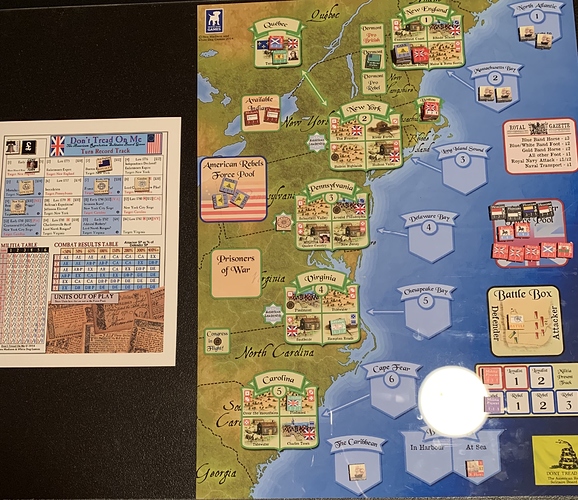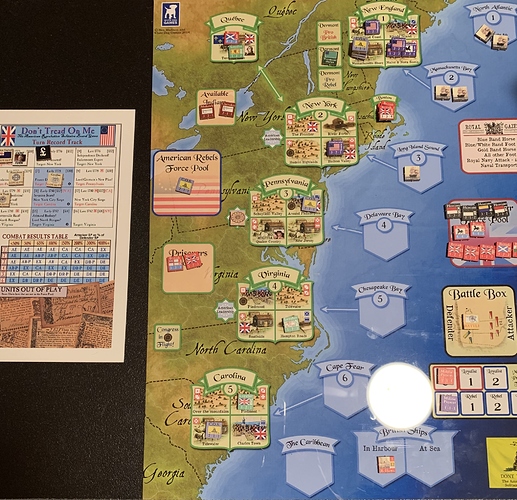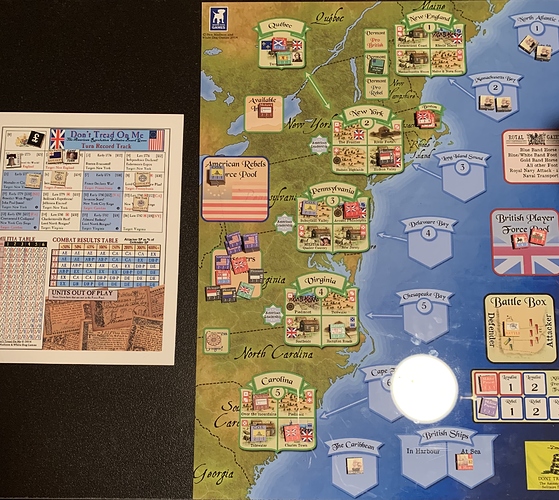Don’t Tread on Me, the American Revolution Solitaire Board Game, by R. Ben Madison
After playing through The White Tribe several times, including the playthrough earlier in this thread, I decided that I would give some of R. Ben Madison’s other games a try. Madison has a “British Wars Trilogy,” which covers the American Revolution, the Napoleonic Wars, and the Falklands, all from the perspective of the British. I’ve decided to tackle them chronologically.
Don’t Tread on Me takes the perspective that the American Revolution was Britain’s Vietnam War, and adapts David Kershaw’s Vietnam Solitaire system to deal with eighteenth century counterinsurgency warfare. In order to secure the American Colonies for the crown, the player must keep Liberty low, by controlling a majority of the five spaces on the board (representing New England, New York, Pennsylvania, Virginia, and the Carolinas/Georgia), including whichever space the government back in Britain wants the player to hold (the “Target Space”).
Don’t Tread on Me’s phases work as follows:
-
Force Adjustment: The player receives his allocations of pounds from Parliament, and then checks the turn record track for any news, which will trigger an event.
-
Smugglers Phase: Smugglers and Privateers form crucial building blocks for the American rebellion. Each turn, Smugglers move from the Caribbean to sea zones bordering the various colonies. When a Smuggler occupies a sea zone, they provide arms and equipment to the rebels, allowing the creation of one Continental Army unit per Smuggler. As the game progresses, the Rebels obtain Privateers, which act as Smugglers that can fight back against any British efforts to blockade the colonies.
-
Naval Phase The British may sortie naval units to attack Smugglers or Privateers. In order to attack, the player must pay the cost indicated on the fleet (1 or 2 Pounds), and then roll equal to or below the units strength (3 or 4). If successful, the Smuggler/Privateer is eliminated. Privateers get to take a shot first, and hit on a 1 or 2, sending the British unit to the harbor before it gets to shoot. In addition, once the French intervene, the British may send a naval unit to shadow the French fleet, which makes it harder for the French to intervene in battle.
-
British Ground Phase: In this phase, the British implement winter attrition on the Continental Army, parole prisoners of war, and purchase troops. Hessians (black counters) must be purchased first. Hessians generally anger the Americans, and do not contribute to control of a state, and so are less useful overall than Regulars, Cavalry, or Loyalists. British units can then move within a state, or force march to move between states, at a risk that the unit will be eliminated.
-
Battle Procedure: We take a short detour from the phases to discuss battles. Battles occur when Rebel and British ground units occupy the same county within a colony. In battles triggered during the British Ground Phase, the Brits have the initiative and get to choose the order in which battles resolve. In later phases, the Rebels have the initiative, and battles are fought top to bottom on the map. Before each battle, the Brits and Rebels call for the militia, the results of which are based on the state’s loyalty to the crown. Units have three strength points, which determine their strength in each of the terrain types (Wilderness-Farm-Town/Fort). Per standard wargaming convention, SPs are added up, an odds ratio is established, and a die is rolled on the combat results table to determine what happens. Stacks can be eliminated, retreat (with or without pursuit), counterattack, or result in an exchange (eliminating the lower strength side and reducing the higher strength side equal to the strength points of the lower strength side
Understanding the retreat rules are vital for the player. When the British retreat, they follow a priority list. First, if the French Fleet is adjacent, the British may not retreat by sea, and are eliminated if retreating from a county marked on the map with a blue die. Second, the British retreat to a county containing friendly units. Third, the British retreat to a county containing units of both sides. If a British unit is in a loyalist stronghold (marked with a Union Jack on the map) they may retreat to sea. If none of these conditions are met, the British units are eliminated. Rebels may retreat to an empty county, and thus are spared elimination–although they scatter if they are retreating from the lowest numbered county, and go back to the force pool.
After a battle, if the British win, the state becomes more loyal (+1 loyalty), unless Washington is present. If the Rebels win, the state becomes less loyal (-1 loyalty).
-
Place Rebels Phase: Committees of Safety (COS) and Continental Army Units deploy on the map. One or Two COS units are placed per turn via die roll. After that, Continental Army units are placed in colonies adjacent to sea zones with Smugglers. Smugglers in the North Atlantic always place Continental Army units in the Target Space. Battles occur.
-
Rebel Campaigns In this phase, Rebels launch a major campaign or two minor campaigns, based on die rolls. In a minor campaign, the rebels place a Continental Army unit in the higher numbered colony, and a COS unit in the lower numbered colony, gather their forces, and battle Brits in the state. In a major campaign, the Rebels gather forces from across the map, and potentially roll through the major campaign state into the target state. We will engage campaigns in more detail as they occur.
-
Logistics Phase: In states where the British have “Lobsters” (red colored British units), the player may spend one pound to increase loyalty by one. The British may then move any of their units to any county in any colony for one pound each.
-
Liberty Phase: The British tally up colony control. If the British fail to control a majority of colonies, or fail to control the target state, liberty advances by one. If the Rebels control Quebec, liberty advances by one. If Liberty reaches 9 or higher, the rebels win. At any time during turn 14 or 15, the British player may concede American independence in exchange for a Marginal British Victory (the historical result). Otherwise, play continues until the end of Turn 16.
-
Random Events Phase Assuming the British do not lose the game due to Liberty, a set of random events happen, which are generally unfavorable to the British.
At the beginning of the game, New England is both the Target State and a hotbed of revolution. It will be almost impossible to hold New England and control a majority of colonies, given constraints on the British. The board begins as follows, with the British about to be ambushed by Rebels in Massachusetts:
(Sorry about the reflection from the overhead light off the plexiglass.)
I will try and do a few moves every day, but may be distracted at some points. I’ve played around with the system a bit (and suffered some catastrophic losses until I figured out the retreat rules), but have not played a full game to completion yet. My apologies for any rules errors as I play through.



